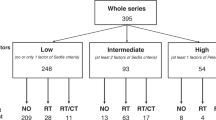Abstract
Currently the prognostic value of lymphovascular space involvement (LVSI) in patients with cervical cancer is unclear. We evaluated the prognostic impact of different categories of LVSI on overall survival (OAS) and disease-free survival (DFS) in a Middle-European population of women with surgically staged, early cervical cancer. The records of 281 women with clinically and histologically diagnosed early cervical cancer undergoing primary surgical treatment at the University of Ulm School of Medicine between 1992 and 2006 were retrospectively reviewed. LVSI as determined by hematoxylin–eosin staining was topographically categorized as conjoined-LVSI and satellite-LVSI. The effect of LVSI, tumor stage, lymph node metastases, and histology on OAS and DFS was assessed by Cox regression analyses. Tumor size and nodal status could be confirmed as significant prognostic factors for OAS and DFS in early-stage cervical cancer. While no significant effect of LVSI in general (satellite-LVSI or conjoined-LVSI) on OAS and DFS was calculated, the presence of satellite-LVSI was associated with significant decreased rates of both, OAS and DFS. We propose satellite-LVSI as new risk factor for patients with early-stage cervical cancer, in order to better identify the patients urgently needing adjuvant therapy.




Similar content being viewed by others
References
Landoni F, Maneo A, Colombo A, Placa F, Milani R, Perego P, et al. Randomised study of radical surgery versus radiotherapy for stage Ib-IIa cervical cancer. Lancet. 1997;350(9077):535–40.
Creasman WT, Kohler MF. Is lymph vascular space involvement an independent prognostic factor in early cervical cancer? Gynecol Oncol. 2004;92(2):525–9.
Kenter GG, Ansink AC, Heintz AP, Delemarre J, Aartsen EJ, Hart AA. Low stage invasive carcinoma of the uterine cervix stage I-IIA morphological prognostic factors. Eur J Surg Oncol. 1988;14(2):187–92.
Atasii T, Aksu MF, Cetinkaya MB. Prognostic factors that affect survival after the treatment of early stage cervical carcinoma. Int Surg. 2000;85(2):147–51.
Burghardt E, Baltzer J, Tulusan AH, Haas J. Results of surgical treatment of 1028 cervical cancers studied with volumetry. Cancer. 1992;70(3):648–55.
Kim SM, Choi HS, Byun JS. Overall 5-year survival rate and prognostic factors in patients with stage IB and IIA cervical cancer treated by radical hysterectomy and pelvic lymph node dissection. Int J Gynecol Cancer. 2000;10(4):305–12.
Trattner M, Graf AH, Lax S, Forstner R, Dandachi N, Haas J, et al. Prognostic factors in surgically treated stage ib-iib cervical carcinomas with special emphasis on the importance of tumor volume. Gynecol Oncol. 2001;82(1):11–6.
Tsai CS, Lai CH, Wang CC, Chang JT, Chang TC, Tseng CJ, et al. The prognostic factors for patients with early cervical cancer treated by radical hysterectomy and postoperative radiotherapy. Gynecol Oncol. 1999;75(3):328–33.
Dawlatly B, Lavie O, Lopes A. Transvaginal evisceration of small bowel after radical hysterectomy and pelvic lymphadenectomy. Gynecol Oncol. 1999;73(1):165–6.
Shingleton HM, Gore H, Bradley DH, Soong SJ. Adenocarcinoma of the cervix I Clinical evaluation and pathologic features. Am J Obstet Gynecol. 1981;139(7):799–814.
Schwartz SM, Weiss NS. Increased incidence of adenocarcinoma of the cervix in young women in the United States. Am J Epidemiol. 1986;124(6):1045–7.
Boon ME, de Graaff Guilloud JC, Kok LP, Olthof PM, van Erp EJ. Efficacy of screening for cervical squamous and adenocarcinoma The Dutch experience. Cancer. 1987;59(4):862–6.
Leminen A, Paavonen J, Forss M, Wahlstrom T, Vesterinen E. Adenocarcinoma of the uterine cervix. Cancer. 1990;65(1):53–9.
Hopkins MP, Morley GW. A comparison of adenocarcinoma and squamous cell carcinoma of the cervix. Obstet Gynecol. 1991;77(6):912–7.
Miller BE, Flax SD, Arheart K, Photopulos G. The presentation of adenocarcinoma of the uterine cervix. Cancer. 1993;72(4):1281–5.
Eifel PJ, Burke TW, Morris M, Smith TL. Adenocarcinoma as an independent risk factor for disease recurrence in patients with stage IB cervical carcinoma. Gynecol Oncol. 1995;59(1):38–44.
Samlal RA, van der Velden J, Ten Kate FJ, Schilthuis MS, Hart AA, Lammes FB. Surgical pathologic factors that predict recurrence in stage IB and IIA cervical carcinoma patients with negative pelvic lymph nodes. Cancer. 1997;80(7):1234–40.
Anton-Culver H, Bloss JD, Bringman D, Lee-Feldstein A, DiSaia P, Manetta A. Comparison of adenocarcinoma and squamous cell carcinoma of the uterine cervix: a population-based epidemiologic study. Am J Obstet Gynecol. 1992;166(5):1507–14.
Author information
Authors and Affiliations
Corresponding author
Rights and permissions
About this article
Cite this article
Herr, D., König, J., Heilmann, V. et al. Prognostic Impact of Satellite-Lymphovascular Space Involvement in Early-Stage Cervical Cancer. Ann Surg Oncol 16, 128–132 (2009). https://doi.org/10.1245/s10434-008-0185-7
Received:
Revised:
Accepted:
Published:
Issue Date:
DOI: https://doi.org/10.1245/s10434-008-0185-7




